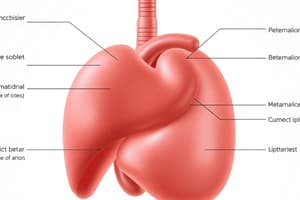Podcast
Questions and Answers
What are the functions of the liver? (Select all that apply)
What are the functions of the liver? (Select all that apply)
- Bile synthesis (correct)
- Hematological functions (correct)
- Respiration
- Metabolism regulation (correct)
What is metabolism regulation?
What is metabolism regulation?
Absorbs nutrients and toxic materials from the blood, maintains blood levels of organic nutrients such as glucose, and absorbs and stores fat-soluble vitamins and iron.
What are hematological functions?
What are hematological functions?
Removes damaged and aged red blood cells, produces plasma proteins for blood osmotic homeostasis, and synthesizes clotting factors.
What is bile synthesis?
What is bile synthesis?
What is nutrient homeostasis?
What is nutrient homeostasis?
What happens if filtration of particulates is impaired?
What happens if filtration of particulates is impaired?
What is protein synthesis in the liver?
What is protein synthesis in the liver?
What occurs in bio-activation and detoxification?
What occurs in bio-activation and detoxification?
What is the role of the liver in glucose regulation?
What is the role of the liver in glucose regulation?
What happens when blood glucose levels fall?
What happens when blood glucose levels fall?
What is the functional unit of the liver?
What is the functional unit of the liver?
What defines the portal triad?
What defines the portal triad?
What are the three zones of the liver?
What are the three zones of the liver?
What is the characteristic of Zone 1 of the liver?
What is the characteristic of Zone 1 of the liver?
What is the characteristic of Zone 3 of the liver?
What is the characteristic of Zone 3 of the liver?
What mechanisms can lead to liver toxicity?
What mechanisms can lead to liver toxicity?
What is necrosis?
What is necrosis?
What is apoptosis?
What is apoptosis?
Where can cell death occur in the liver?
Where can cell death occur in the liver?
Flashcards are hidden until you start studying
Study Notes
Functions of the Liver
- Major functions include metabolism regulation, hematological functions, bile synthesis, protein synthesis, and filtration of particulates.
Metabolism Regulation
- Absorbs nutrients and toxins from blood
- Maintains blood organic nutrient levels, especially glucose
- Stores fat-soluble vitamins (A, D, K, E) and iron
Hematological Functions
- Removes aged and damaged red blood cells
- Produces plasma proteins for blood osmotic balance
- Synthesizes clotting factors necessary for hemostasis
Bile Synthesis
- Produces bile salts essential for fat and fat-soluble vitamin absorption
Nutrient Homeostasis
- Manages glucose storage and synthesis, and cholesterol uptake
- Impairment leads to conditions like hypoglycemia and hypercholesterolemia
Filtration of Particulates
- Filters substances such as products from intestinal bacteria
- Impaired filtration can cause endotoxemia
Protein Synthesis
- Synthesizes key proteins including clotting factors and albumin
- Impairment results in excess bleeding and complications like ascites and fatty liver
Bio-activation and Detoxification
- Processes substances like bilirubin, ammonia, and xenobiotics
- impairments can cause jaundice and hyperammonemia-related coma
Formation of Bile and Biliary Secretion
- Involves bile acid-dependent uptake of dietary lipids and vitamins
- Impairment leads to fatty diarrhea, vitamin deficiencies, and gallstones
Glycogen Dynamics
- Liver removes glucose from blood for storage as glycogen (glycogenesis)
- When blood glucose levels drop, liver performs glycogenolysis and gluconeogenesis to restore balance
Liver Structure
- Contains functional structural units called lobules which include hepatocytes, sinusoids, and a central vein
Functional Unit (Lobule)
- Hepatocytes arranged around a central vein, resembling spokes of a wheel
- Sinusoids are the spaces between sheets of hepatocytes
Portal Triad
- Comprises three structures located between lobules: portal vein, bile duct, and hepatic artery
Zones of the Liver
- Divided into three zones based on oxygen supply: zones 1, 2, and 3.
Zone 1
- Located around portal tracts with high oxygen concentration from hepatic arteries
Zone 2
- Lies between zones 1 and 3
Zone 3
- Found around central veins with lower oxygen concentrations
Mechanisms of Liver Toxicity
- The liver is a primary target organ for toxins due to its extensive blood supply and "first pass" metabolism
- High concentrations of detoxifying enzymes (like P450s) can bioactivate toxins into more harmful metabolites
Results of Liver Toxicity
- Can lead to cell death, cholestasis, bile duct damage, sinusoidal disruption, fatty liver, fibrosis, cirrhosis, and tumors
Pathways of Cell Death
- Necrosis: Involves inflammation and affects groups of cells
- Apoptosis: Affects single cells and is characterized by lack of inflammation
Locations of Cell Death
- Can occur either widely throughout the liver or in specific zonal areas
Mechanisms of Cell Death
- Pathys of cell death determined by various stressors and toxicants affecting cellular integrity.
Studying That Suits You
Use AI to generate personalized quizzes and flashcards to suit your learning preferences.




